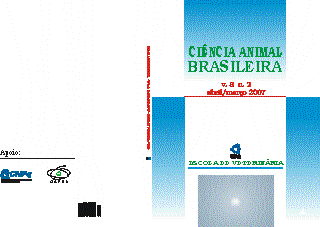VAGINAL CYTOLOGY PROFILE FOR ACCOMPANIMENT TO ESTROUS CYCLE IN BREED SANTA INÊS EWES
Keywords:
Citologia, ovinos, reproduçãoAbstract
The objective of this work was to establish a vaginal cytological profile in ewe of the Race Saint Inês, during a complete estrous cycle. Five created cyclical females in half-intensive system had been selected, in the Farm Rocks Saint, Araguaína, TO. The vaginal smears had been made daily during the estrous cycle, detected for a ruffian. One was confectioned vaginal smears for female, in dry glass slides to the ambient temperature and settled in alcohol 95% and in followed. They had been staining by the fast panótico method. The glass slides had been observed to the optic microscope with increases of 10 x and 40 x for counting of 100 cells and visualization of the morphologic and staining characteristics of the epithelial cells to the long one of the estrous cycle. The changeable phases of the estrous cycle – proestrous, estrous, metoestrum and diestrum – e types cells – basal, parabasal, anuclear superficial –, intermediate and had been studied by means of ANOVA, to the level of probability of 5% for the test of Tukey. The some types cells of the vaginal epithelium had been found to the long one of the phases of the estrous cycle and evaluated four types of cells: nuclear superficial, intermediate, basal and parabasal. In the phase of estrous a difference was noticed statistics of the anuclear superficial cells on the too much types (P<0,05). One concluded that through the exfoliation vaginal cytology it can be differentiated the phases of the estrous cycle in ewe of the race Saint Inês.
KEY-WORDS: Estrous cycle, ewe, vaginal cytology, vaginal epithelium.
Downloads
Downloads
Published
How to Cite
Issue
Section
License
Copyright (c) 2007 Brazilian Animal Science/ Ciência Animal Brasileira

This work is licensed under a Creative Commons Attribution 4.0 International License.
Authors who publish with this journal agree to the following terms:
- Authors retain copyright and grant the journal right of first publication with the work simultaneously licensed under a Creative Commons Attribution License that allows others to share the work with an acknowledgement of the work's authorship and initial publication in this journal.
- Authors are able to enter into separate, additional contractual arrangements for the non-exclusive distribution of the journal's published version of the work (e.g., post it to an institutional repository or publish it in a book), with an acknowledgement of its initial publication in this journal.
- Authors are permitted and encouraged to post their work online (e.g. in institutional repositories or on their website) prior to and during the submission process, as it can lead to productive exchanges, as well as earlier and greater citation of published work (See The Effect of Open Access).




























